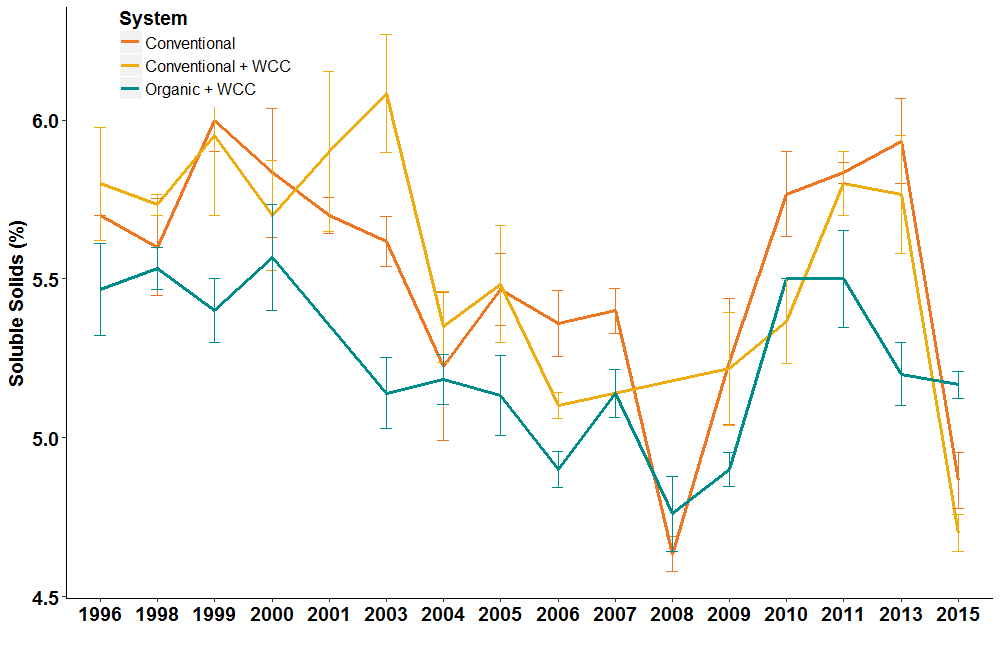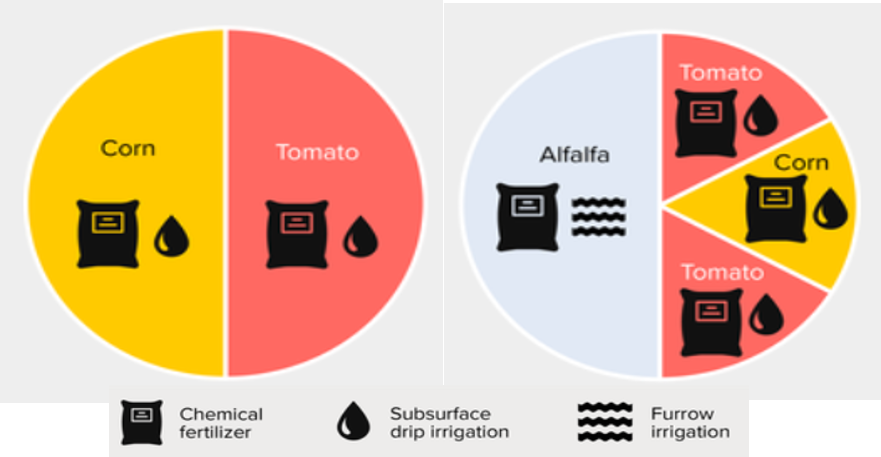We are exploring how different farm management methods affect yields, fruit quality, and disease pressure/resistance.
Plant Health and Productivity in Context
- Healthy plants help maintain sustainable and profitable crop production
- Plants that are healthy are more resilient to changes in climate (can be more drought tolerant) and pest pressure/disease
- High nutrient content in healthy plants provides a more quality crop product for human and animal consumption
How we look at plant health and productivity
We are investigating ways to Improve plant health and crop productivity. Key research questions we are exploring include:
Featured Research Projects
- Tomato yield trends over time


- Tomato soluble solid (%) trends over time

- Disease pressure and resistance
-
One study featured in our 2018 Research Progress Report (A. Gaudin, C. Casteel, R. Vannette, R. Blutnell, J. Schmidt, T. Bowles, and F. Bender, UC Davis and UC Berkeley) found that organic fields had lower pest populations compared to conventional sites and that differences were due partially to increased plant resistance. Beet leafhoppers consistently prefer to settle on conventionally grown tomato plants rather than organically grown plants at Russell Ranch.

Figure 1: Organic management practices reduced insect populations and preference in processing tomatoes. (A) The number of insects collected in sweepnets on organic and conventional plots of tomato at Russell Ranch (Farm RR) in 2016. (B) The number of insects collected in sweepnets on organic and conventional plots at Farm RR and three commercial processing tomato farms (Farm F, M, and S) in 2017. (C) Combined arthropod diversity across all sites in 2017. D) Leafhopper settling preference for leaves collected from Farm RR and three commercial processing tomato farms (Farm F, M, and S) in 2017. (mean ± SE; N= 6 for A and B, C, N= 24 for C and N=18 for D). Stars represent significant differences; *P<0.1, **P<0.05). - Optimizing Potassium Fertilizer Uptake Efficiency while Minimizing Costs in Processing Tomato
- Goal:
Identify the method and timing of K fertilization that results in the greatest uptake of K in tomato while minimizing costs; i.e., getting the most K uptake per dollar investment, when comparing fall broadcast to in-season fertilization.
Objectives:(1) Measure exchangeable K in soils at tomato transplanting and early flower
(2) Measure tomato tissue-K levels at full bloom
(3) Evaluate fertilizer and application costs
(4) Compare yields
Read more about the project in the full report. - Benefits of Alfalfa in Rotation
-
Goals:
Exploring the potential of alternative crop rotations to maximize environmental benefits while maintaining high yields and farm profitability.
Methods:
We compared yields, yield responses to N fertilization, soil health indicators, and nitrogen leaching between a traditional 2-year corn-tomato rotation and a 6-year rotation which includes a 3-year Alfalfa period (Figure 1).
Figure 1. Scheme of crop rotation and field management regime Results:
Fruit yields following alfalfa with no N fertilizer applied were equivalent to yields following corn with 180 lb N/acre applied, indicating an N fertilizer credit of 180 lb N/acre from alfalfa in rotation (Figure 2).
Microbial biomass C and N increased significantly following Alfalfa in rotation, as did soil aggregate stability, signifying benefits to soil health.
Lower nitrate leaching was observed under alfalfa compared to corn both with and without cover crop (Figure 3).
Figure 2. Tomato yield responses to N fertilizer application in 2-year (blue) and 6-year (green) crop rotations

Figure 2. Tomato yield responses to N fertilizer application in 2-year (blue) and 6-year (green) crop rotations -
-